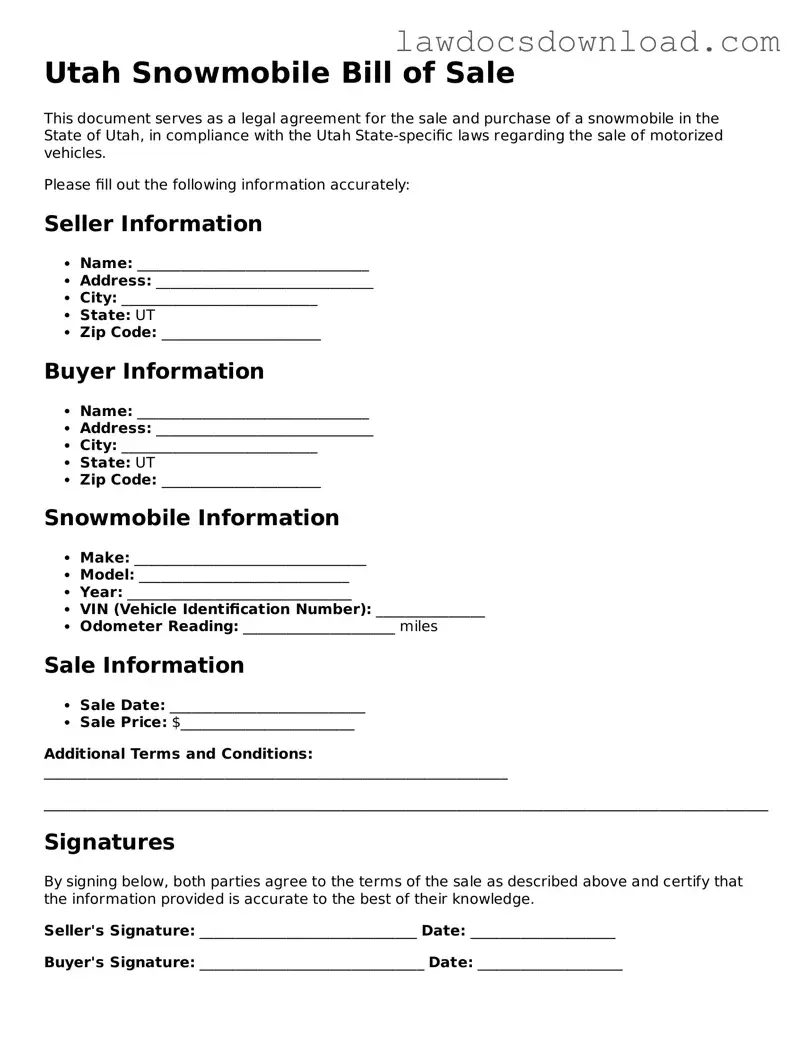In the frosty landscapes of Utah, snowmobiles buzz through the winter air, etching paths in the snow and creating memories. As thrilling as it may be to buy or sell these winter steeds, the transaction isn't complete without navigating the paperwork, specifically the Utah Snowmobile Bill of Sale form. Sadly, it's all too common for people to stumble through this process, making mistakes that can lead to headaches down the line. Knowing these pitfalls can ensure a smoother transaction for all parties involved.
One of the first and most significant blunders is neglecting to verify the accuracy of the vehicle identification number (VIN). This seemingly minor oversight can lead to major complications, including legal issues concerning the snowmobile’s ownership and history. Ensuring that the VIN on the snowmobile matches the one on the bill of sale is paramount.
Another common mistake is opting to leave the purchase price blank or inaccurately represented. This might be done with the intention to save on taxes, but it can create legal issues for both parties. The state uses this information to assess sales tax, and discrepancies may result in penalties or fines.
Frequently, individuals rush through the process, forgetting to include a detailed description of the snowmobile. This includes color, make, model, and year, which are essential for identifying the vehicle in question. This omission can complicate matters if there are disputes or claims about the condition or features of the snowmobile later on.
A major pitfall is the failure to acknowledge the "As-Is" clause. Many buyers and sellers do not understand that this clause means the snowmobile is being sold in its current condition, and any future problems become the buyer's responsibility. Clarifying this on the bill of sale can prevent legal disputes about the state of the snowmobile post-purchase.
Both buyers and sellers often underestimate the importance of signing and dating the document. This simple yet critical step legally binds the agreement. Ignoring this formality can render the transaction invalid or complicate legal claims if disagreements arise later on.
Skipping the step of obtaining a notary’s signature is another oversight. While not always mandatory, having the bill of sale notarized adds a layer of legal protection and authenticity, ensuring that the document is more robust against fraud.
Another mistake is not providing or keeping copies of the bill of sale. Both parties should have a copy for their records. This document serves as a receipt and is crucial for registration, insurance, and potential legal matters.
Last but not least, individuals sometimes neglect to check if additional documents are required by their local Department of Motor Vehicles (DMV). Certain situations may call for extra paperwork, such as a release of liability or registration forms, to complete the transaction according to state laws.
Avoiding these errors can streamline the process, save time, and prevent legal issues. Whether you're skating through snowy trails or navigating the sale of a snowmobile, preparation, and attention to detail are your best allies.
